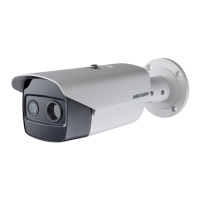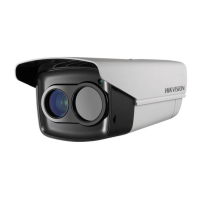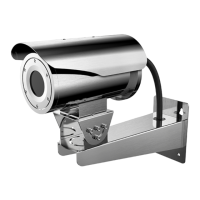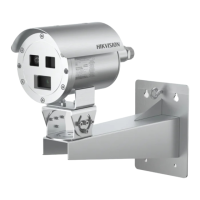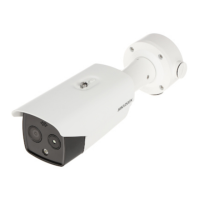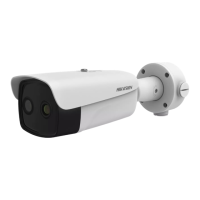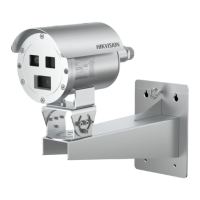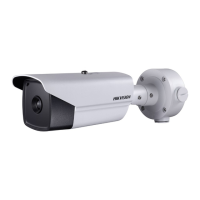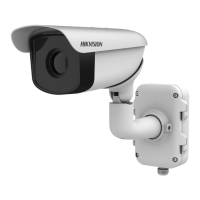
Do you have a question about the HIKVISION DS-2TD2367-75/PY and is the answer not in the manual?
| Thermal Module: Response Waveband | 8 μm to 14 μm |
|---|---|
| Temperature Measurement | Yes |
| Temperature Measurement Range | -20 °C to 150 °C (-4 °F to 302 °F) |
| Interface | 1 RJ45 10M/100M Self-adaptive Ethernet interface |
| Bit Rate | 32 Kbps to 16 Mbps |
| Protection Level | IP67 |
| Ingress Protection | IP67 |
| Weight | Approx. 2.35 kg (5.18 lb) |
| Thermal Module: NETD | ≤ 40 mK @ f/1.0 |
| Thermal Sensitivity (NETD) | ≤ 40 mK @ f/1.0 |
| Thermal Module: Aperture | F1.0 |
| Image Enhancement | 3D DNR |
| Temperature Measurement Accuracy | ±2°C or ±2% (whichever is greater) |
| Video Compression | H.265/H.264 |
| Compression | H.265/H.264 |
| Audio Compression | G.711u |
| Protocols | IPv4/IPv6, HTTP, HTTPS, NTP, DHCP, DNS, PPPoE, DDNS, FTP, 802.1x, Qos |
| Video Output | 1 channel |
| Power Supply | PoE (802.3at) |
| Operating Conditions | Humidity 95% or less (non-condensing) |
| Alarm Input | 1 channel |
| Alarm Output | 1 channel |
| Alarm Trigger | Temperature alarm |
| Focal Length Adjustment | Fixed focus |
| Camera Type | Thermal & Optical Bi-spectrum Network Bullet Camera |
| Thermal Module: Image Sensor | Uncooled vanadium oxide (VOx) microbolometer |
| Field of View | 32° × 24° (thermal), 79° × 43° (optical) |
| Field of View (H × V) | 32° × 24° (thermal), 79° × 43° (optical) |
Provides instructions for using and managing the product, including charts, pictures, and explanations.
Lists Hikvision trademarks and logos, and those of other respective owners.
Outlines limitations of liability, warranties, and user responsibilities for product usage.
Indicates a hazardous situation which, if not avoided, will or could result in death or serious injury.
Indicates a potentially hazardous situation which, if not avoided, could result in equipment damage, data loss, or performance degradation.
Provides additional information to emphasize or supplement important points of the main text.
Emphasizes strict compliance with electrical safety regulations during product use.
Provides guidelines for safely transporting the device in original packaging.
Details requirements for power supply, including voltage and connection safety.
Discusses battery handling, disposal, and precautions against explosion or damage.
Provides guidelines for installing the equipment in a stable and secure location.
Addresses inherent internet security risks and user responsibilities for data protection.
Covers basic maintenance, component replacement, and cleaning instructions.
Specifies operating temperature, humidity, and environmental conditions for the device.
Provides immediate actions for smoke, odor, or noise arising from the device.
Introduces the thermal network camera, its GPU capabilities, and applications.
Outlines the main functions: Fire Detection, Temperature Measurement, and VCA.
Guides users on activating the device using SADP software for network access.
Details the process of activating the device through a web browser interface.
Explains how to log in to the device via a web browser.
Covers plug-in installation requirements for Windows and Mac OS for normal operation.
Enhances security by enabling illegal login lock and configuring attempts and duration.
Provides important notices and recommendations for configuring temperature measurement.
Presents a visual flowchart outlining the process of configuring temperature measurement.
Explains how to configure temperature measurement parameters and rules for automatic detection.
Details the configuration of various temperature measurement parameters for the device.
Options for displaying temperature units: Celsius, Fahrenheit, or Kelvin.
Selects the temperature measurement range, with an auto-adjustment option.
Selects the distance mode for temperature measurement: Fixed Distance or Self-Adaption.
Configures temperature measurement for the entire scene, including thresholds.
Sets the temperature threshold for triggering a pre-alarm.
Sets the temperature threshold for triggering a full alarm.
Configures temperature measurement rules like Point, Line, or Area in expert mode.
Guides on customizing and selecting temperature measurement rules for the device.
Details on setting temperature thresholds and comparing temperatures in different areas.
Sets temperature thresholds for alarms and pre-alarms with examples.
Sets tolerance for temperature changes to prevent false alarms.
Configures temperature measurement for a specific point in the live view.
Configures temperature measurement for a line drawn in the live view.
Defines areas to exclude from temperature detection to avoid interference.
Enables manual temperature readings by clicking on any position in the live view.
Configures parameters for detecting fire sources and triggering alarms.
Configures parameters for detecting smoking behavior and outputting alarms.
Suggests optimal installation locations for effective fire source detection.
Details configuration steps for fire detection parameters to prevent potential fire damage.
Explains how to set parameters like detection mode and sensitivity for fire detection.
Selects between Smoking Mode and Dynamic Fire detection.
Adjusts the sensitivity for fire detection; higher value means easier detection but higher false rate.
Presents a flowchart illustrating the process of configuring perimeter protection.
Configures VCA parameters such as display information and snapshot settings.
Details the process of calibrating the camera for accurate measurements and analysis.
Guides users through the steps for performing automatic camera calibration.
Provides instructions for manually calibrating the camera using reference lines.
Explains how to verify the consistency of calibrated values with actual measurements.
Configures detection rules for perimeter protection to trigger alarms when VCA rules are broken.
Details rule types like Line Crossing, Intrusion, and Region Entrance/Exit.
Sets rules for detecting targets crossing a defined line, including direction and sensitivity.
Sets rules to detect targets intruding into a predefined region for a specified duration.
Configures advanced VCA parameters like single alarm, scene modes, and parameter restoration.
Configures motion detection to identify moving objects and trigger linkage actions.
Sets motion detection parameters in normal mode, including sensitivity and area drawing.
Sets motion detection parameters in expert mode, including day/night switch options.
Configures alarms for video tampering events, including sensitivity and area definition.
Configures handling of external alarm signals from connected devices.
Configures device responses to exceptions like HDD full or network disconnection.
Detects abnormal audio events like sudden sound intensity changes.
Details on detecting sudden decrease of sound intensity and setting sensitivity.
Sets the valid time periods for device tasks and schedules.
Configures how the device responds to events or alarms, including output and notification methods.
Configures sending alarm information to an external alarm output device.
Configures uploading alarm information to FTP, NAS, or memory card storage.
Configures sending email notifications with alarm information and attached pictures.
Uploads alarm information to a surveillance center for monitoring.
Configures recording video clips automatically when an alarm event is detected.
Triggers audible alarms as a warning when targets are detected in the detection area.
Configures flashing or solid alarm light output based on alarm events.
Introduces live view parameters, function icons, and transmission parameters settings.
Sets the aspect ratio for the live view window (e.g., 16:9, 4:3).
Enables digital zoom to view detailed information of any region in the image.
Offers a quick setup for PTZ, display, OSD, video/audio, and VCA settings on the live view page.
Used to adjust the lens focus, zoom, iris, and PTZ speed for optimal image clarity.
Adjusts transmission parameters to solve issues with live view image display in different network conditions.
Selects transmission protocols: TCP, UDP, MULTICAST, or HTTP.
Sets preferences for real-time delay versus video fluency.
Sets preferences for real-time delay versus video fluency: Shortest Delay, Balanced, or Fluent.
Configures video parameters including stream type, video type, resolution, and bitrate.
Selects between Main Stream for best performance and Sub Stream for lower bandwidth.
Sets video resolution based on actual needs, balancing quality with bandwidth and storage.
Configures bitrate type (Constant or Variable) and maximum bitrate for video streams.
Configures video quality settings, noting higher quality requires more bandwidth.
Sets the frame rate (fps) for video streams, impacting smoothness and bandwidth.
Selects video compression standards like H.264, H.265, and MJPEG.
Explains video encoding profiles, I-Frame Interval, and Scalable Video Coding (SVC).
Defines the interval between I-frames, affecting data stability and storage.
Adjusts stream smoothness and fluency, balancing quality with flow.
Configures how VCA information is displayed by player or video.
Configures audio parameters such as encoding, noise filtering, and input types.
Filters environmental noise to improve audio clarity.
Enables two-way audio communication between the monitoring center and the target.
Configures Region of Interest encoding to enhance quality in specific areas.
Offers parameter settings to adjust image features like brightness, contrast, and noise reduction.
Optimizes the image display effect of the thermal channel via manual correction.
Explains AGC modes for balancing image quality and DNR for noise reduction.
Selects AGC mode (Histogram, Linear, Self-Adaptive) for balancing image quality.
Configures Digital Noise Reduction (Normal, Expert, OFF) to improve image quality.
Selects palette modes to display thermal grayscale images in colored formats.
Sets colors for different temperature ranges to quickly identify targets.
Adjusts image details using Digital Detail Enhancement (OFF or Normal modes).
Improves coding quality for specific image areas by selecting a desired region.
Flips the live view image horizontally to display the scene normally.
Selects predefined scene modes for optimized display settings based on environment.
Customizes On-screen Display information such as device name, time, and text overlay.
Blocks certain areas in the live view to protect privacy, ensuring they are never seen.
Overlays a customized picture onto the live view, requiring BMP format and specific dimensions.
Manually corrects defective pixels in the image for improved accuracy.
Configures common storage paths for recorded video and captured images.
Guides on inserting and formatting memory cards for storing device files.
Configures network-attached storage (NAS) for saving record files and captured images.
Configures FTP server settings for saving captured images and videos.
Configures uploading captured pictures and data to the cloud for analysis.
Introduces operations for manual and scheduled recording, playback, and downloading.
Configures automatic video recording during specific time periods or based on events.
Details recording modes: Continuous, Motion, Alarm, Motion | Alarm, Motion & Alarm, Event.
Sets continuous video recording based on the configured schedule.
Records video when motion detection is enabled and trigger recording is linked.
Records video after receiving an alarm signal from an external input device.
Starts and stops video recording manually, setting file size and saving path.
Searches, plays back, and downloads video files stored locally or on network storage.
Configures automatic and manual picture capturing, including format and resolution.
Configures automatic picture capturing based on time intervals or triggered events.
Captures pictures manually from the live view or playback window.
Searches, views, and downloads captured pictures stored locally or on network storage.
Configures TCP/IP settings, supporting both IPv4 and IPv6 for network communication.
Configures IPv4 network settings using DHCP or manual IP address assignment.
Configures IPv6 network settings using Route Advertisement, DHCP, or manual assignment.
Enables multicast discovery for automatic detection of network cameras.
Configures network ports for device access, including HTTP, HTTPS, and RTSP ports.
Configures port mapping to access devices through specified ports.
Guides on setting up automatic port mapping using UPnP for easier access.
Guides on setting up manual port mapping by configuring external and internal ports.
Configures multicast settings for efficient data transmission to multiple receivers.
Configures SNMP for network management, alarm events, and exception messages.
Configures Dynamic DNS (DDNS) for network access via a domain name.
Sets up PPPoE parameters for dial-up internet connection to obtain a public IP address.
Guides on enabling the Hik-Connect service for remote access via SADP or web browser.
Enables Hik-Connect service by configuring platform access mode via a web browser.
Enables Hik-Connect service for an activated camera using SADP software.
Explains how to access the camera using the Hik-Connect mobile application.
Registers the device on ISUP platform for remote management and data transmission.
Configures user settings for Open Network Video Interface protocol to enhance security.
Sends alarm signals to a remote alarm host (PC with client software).
Sends alarms to a destination IP address via HTTP, HTTPS, or ISUP protocol.
Controls the ON/OFF status of network protocols like WebSocket and WebSockets.
Configures Secure Real-time Transport Protocol for encrypted data transmission.
Displays device details including number, model, serial number, and firmware version.
Helps locate and troubleshoot problems by searching and managing log files.
Speeds up batch configuration by importing or exporting device configuration files.
Exports diagnose information, including running log, system, and hardware information.
Restarts the device via the web browser interface.
Restores device parameters to default settings, including factory defaults.
Provides instructions for obtaining and performing firmware upgrades on the device.
Displays the open source software licenses used by the device.
Configures time zone, time synchronization, and Daylight Saving Time (DST).
Manually synchronizes the device time with a local PC's time.
Sets up an NTP server for accurate and reliable time synchronization.
Configures Daylight Saving Time settings, including start time, end time, and bias.
Configures RS-232 parameters for debugging and peripheral device communication.
Configures RS-485 parameters for transmitting data over long distances.
Ensures consistent temperature and distance unit settings across the device.
Enhances system security by setting various security parameters.
Configures RTSP and WEB authentication protocols for improved network access security.
Manages security logs for operation analysis and troubleshooting.
Filters IP addresses to allow or forbid access, enhancing control over device access.
Manages server/client certificates and CA certificates for secure communication.
Sets automatic logout timers for web browser sessions to enhance security.
Enables SSH for secure remote login, reserved for professional maintenance.
Enables HTTPS for encrypted transmission and identity authentication during remote access.
Improves network delay and congestion by setting priority for data sending.
Authenticates user permissions of connected devices using IEEE 802.1X.
Manages user accounts and permissions, allowing administrators to grant different levels of access.
Adds, modifies, or deletes user accounts and grants specific permissions to users.
Details assigning permissions to administrators, users, and operators.
Provides a reference table for the emissivity values of common materials.
Provides information on common serial port commands for Hikvision thermal cameras.
Details all communication ports of Hikvision thermal cameras.
Lists frequently asked questions (FAQ) about the device's functionality and usage.
